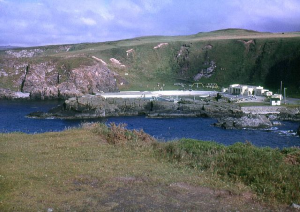 The third NewsBlog reprise on the 2022 Annual School is a contributor’s take on the CPD, now via the team of delegates from Stephen Levrant Heritage Architecture (SLHA) that led the tour of the A-listed Art Deco Tarlair Lido on a busy Saturday, and stayed on to the next week for further team-building.
The third NewsBlog reprise on the 2022 Annual School is a contributor’s take on the CPD, now via the team of delegates from Stephen Levrant Heritage Architecture (SLHA) that led the tour of the A-listed Art Deco Tarlair Lido on a busy Saturday, and stayed on to the next week for further team-building.
image: Tarlair in the 1960s – By Grahame Hadden – CC BY-SA 3.0, https://commons.wikimedia.org/w/index.php?curid=14699883
… The site visits were a welcome opportunity for delegates to see first hand the variety and wealth of historic buildings that Aberdeenshire has to offer…
Declan Cahill of SLHA writes:
Following a packed itinerary on the Thursday and Friday of this year’s IHBC Summer School in Aberdeen, Full School delegates were given the opportunity to visit some of Aberdeenshire’s challenging conservation projects on the Saturday.
The first visit of the day was to Fyvie Castle, where the National Trust for Scotland explained about the conservation challenges of the 13th century castle, its deteriorating masonry and the castles decorative interiors. This included the unusual stabilising method of strapping together a structurally insecure tower by use of stainless steel belts wrapped around the exterior, while more permanent repair methods are investigated.
Following this visit, we were back on the coach to make our way to Tarlair Lido, the Category A-listed (equivalent to England’s Grade I) art-deco lido nestled on the north coast of Aberdeenshire. With swimming known to have been happening on the site since the 1920’s, Burgh Surveyor John C. Miller was instructed to design a building that enabled open-air sea-bathing movement in the natural bay at Tarlair, and took design inspiration from other art-deco buildings at the time, although examples are rare of this building style across Aberdeenshire.
The pavilion at Tarlair is the only known building by Miller and no historic documents were found in our research to date from Tarlair’s construction or evidence of other buildings. The building’s solid concrete construction was a new technology at the time, which ultimately leaves it susceptible to common construction defects, and the pavilion has had to further weather well against the brunt of the north-coast weather and saline conditions. Repairs have been identified to the concrete structure, with the expected reinforcement corrosion and concrete spalling, the repair and refurbishment project will provide some ‘TLC’, as no maintenance has been carried out since being closed and boarded up since 1996.
The site is about to embark on its second phase of works following the re-lining of the upper pool in 2016-17 and successful applications being granted in May 22 to repair, refurbish and extend the pavilion back into a community café and workshop space.
SLHA who are providing heritage consultancy and conservation architectural services to the project team, were in attendance at the tour to explain the current project to the Pavilion. SLHA, through myself and my colleagues, provided an overview of how research and analysis has provided the baseline for a conservation-led approach to be taken to the buildings repair, as well as informing the sensitive design to refurbish and extend the building by project architects Studio Octopi.
Paint analysis has informed decisions to date on proposed paint schemes for the project, through revealing the history and numerous paint schemes that survive, whilst concrete analysis during stage 4 will inform the repair mortars. Photographic evidence and analysis has also had to be employed by the project team to unpick the buildings changes, in particular the form of the lost windows and doors to the north and south elevations.
Delegates were also welcomed by Pat Wain, Chair of the Friends of Tarlair Community Group who have taken on the pavilion from Aberdeenshire Council. Pat provided an insight into the social history of the site and local community that have come together to help galvanise the pavilions rescue. The Friends of Tarlair community group have successfully raised the funds needed through fundraising and grant applications to undertake the project, and bring the boarded up building back into use.
The project is currently being developed through stage 4 design, with the hope to commence on site in autumn 2022.
From Tarlair, attendees went on to visit the Vinery at Banff, followed by visits to a number of historic buildings taken on by the North East Scotland Building Preservation Trust in the historic harbour of Portsoy. The site visits were a welcome opportunity for delegates to see first hand the variety and wealth of historic buildings that Aberdeenshire has to offer, whilst the additional discussion time enabled debate and opinions to be shared about the conservation challenges and approaches in Scotland.
Text kindly provided for readers of the IHBC NewsBlogs etc. by Declan Cahill, SLHA.
See more on the Lido and proposals
Visit the:
Friends of Tarlair community group website
Vinery at Banff Twitter feed
North East Scotland Building Preservation Trust website
See more School reprises:
- Bon Accord Baths and The Little Kicks on video: A first reprise (and more) from #IHBCAberdeen2022
- Second reprise from #IHBCAberdeen2022’s School + MarketPlace: IHBC NewsBlog etc. highlights
See the NewsBlogs for more on #IHBCAberdeen2022

